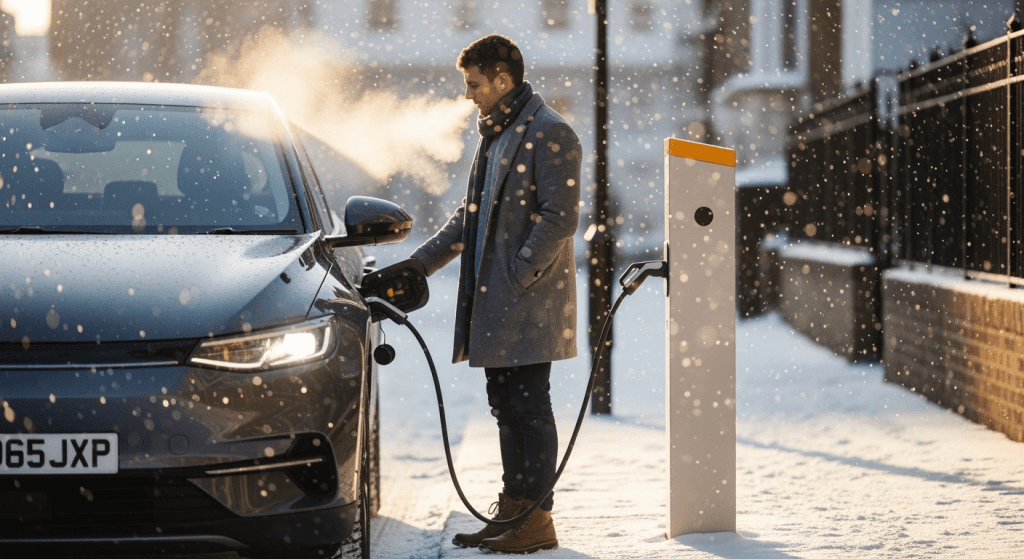UK winters bring icy mornings, slushy roads and reduced visibility — all of which pose unique challenges for electric vehicle (EV) drivers. The good news? With a little preparation and a few smart habits, your EV can handle cold weather confidently. Use this guide to maximise battery performance, stay safe, and plan efficient charging when temperatures drop.
1) Drive smoothly for grip and range
Slippery roads call for gentler inputs. Avoid sudden acceleration, heavy braking or sharp steering. Smooth driving keeps traction under control, reduces the chance of wheelspin and helps conserve battery power — especially useful on cold mornings.
2) Leave more space in poor conditions
Snow, sleet and fog lengthen stopping distances. Leave extra room to the vehicle ahead so you can brake progressively rather than suddenly on icy surfaces. Use your EV’s driver assistance features responsibly (if fitted) and keep speeds appropriate to conditions.
3) Improve traction with winter-ready hardware
Consider winter tyres if you regularly face sub‑7°C temperatures; their compounds and tread patterns maintain grip in cold, wet and snowy conditions. Pair them with your EV’s stability and traction control systems for added security. Check your owner’s manual to confirm recommended tyre types and correct pressures for winter driving.
4) Pre‑condition the cabin and battery while plugged in
Most EVs let you warm the cabin — and in many cases the battery — while still on mains power. Pre‑conditioning means you start with a comfortable cabin and an optimally tempered battery, improving efficiency and initial range. Schedule pre‑heat while connected at home or at a public charger before departure.
5) Heat yourself, not the whole cabin
Cabin heating can be energy‑intensive. Use heated seats and steering wheel (if available) and wear an extra layer to stay warm with less impact on range. Keep demisters on just long enough to clear condensation, then reduce fan speed.
6) Plan smarter routes around the weather
Check live forecasts and road conditions before setting off and build in contingency time. Where possible, stick to well‑travelled roads that are more likely to be gritted and cleared. Daylight departures improve visibility and reduce reliance on battery‑draining lights. For long trips, pin backup charging stops in case of closures or congestion.
Further reading: Met Office winter driving advice and National Highways: driving in winter.
7) Adapt your charging strategy for cold weather
Cold batteries accept charge more slowly, especially at high state of charge. Plan slightly longer charging stops and prioritise reliable, well‑maintained sites. Use the ONEEV app to find chargers with real‑time prices and connector details so you’re never caught out. For cost‑saving ideas, see our guide to the cheapest EV charging stations near you.
8) Don’t depend on regenerative braking on ice
On very slippery surfaces, some cars reduce regenerative braking to preserve stability. Be ready to use conventional braking earlier and more progressively. If your EV offers regen levels, choose a gentler setting in snow or ice for smoother weight transfer.
9) Keep your battery comfortably topped up
In very cold snaps, aim to keep the battery above 20–30% state of charge. Low SOC plus low temperatures can limit power and reduce estimated range. Top up opportunistically at trusted sites — and always allow a margin to reach an alternative charger if needed. If you’re new to public charging times, read our explainer on how long EV charging really takes in the UK.
10) Pack an EV‑ready winter kit
Carry the essentials: warm clothing and blankets, a torch, phone charger and power bank, screenwash rated for sub‑zero use, basic first‑aid kit and high‑vis. For longer trips, add de‑icer, an ice scraper, non‑perishable snacks and water. Keep a list of alternative charging locations saved in your app in case your first choice is busy or offline.
For secure payments and instant receipts on public charging, see how to pay for EV charging securely and why instant receipts matter for EV drivers.
Quick pre‑drive checklist
- Pre‑condition cabin and (where available) battery while plugged in.
- Clear snow/ice fully — roof, lights, cameras and sensors.
- Set a smoother regen level if conditions are slippery.
- Plan a primary and a backup charge stop on your route.
- Keep SOC above 20–30% during cold spells.
FAQs: EV winter driving
How does cold weather affect EV batteries?
Low temperatures reduce battery efficiency, so you may see lower range and slower charging. Pre‑conditioning and keeping the battery topped up help mitigate these effects.
Should I use winter tyres on my EV?
If you regularly drive in cold conditions, winter tyres can significantly improve grip and braking performance. Check your vehicle handbook for approved sizes and load ratings.
What’s the best way to heat the car without losing range?
Pre‑heat the cabin while plugged in, then use heated seats and steering wheel to stay warm with less energy than full cabin heating.
Is regenerative braking safe on icy roads?
Yes, but its effectiveness may be reduced by the car for stability. Select a lower regen setting and brake earlier and more gently on slippery surfaces.
How can I plan winter charging stops?
Use the ONEEV app to find reliable chargers with real‑time prices and connector info, and plan a backup site in case your first choice is busy.
What else should I carry in winter?
Warm layers, blankets, de‑icer, scraper, torch, power bank, high‑vis, basic first‑aid and snacks. Keep alternative charger locations saved offline if possible.
Ready to drive with confidence?
With a little preparation, winter driving doesn’t need to be stressful. From smarter charging to better battery care, ONEEV helps you plan ahead and stay in control. Explore more seasonal advice in our EV road‑trip checklist, and open ONEEV to find nearby chargers with live pricing today.
More expert reads: charging by postcode and why EV pricing transparency matters.
External resources referenced: RAC winter driving advice.
